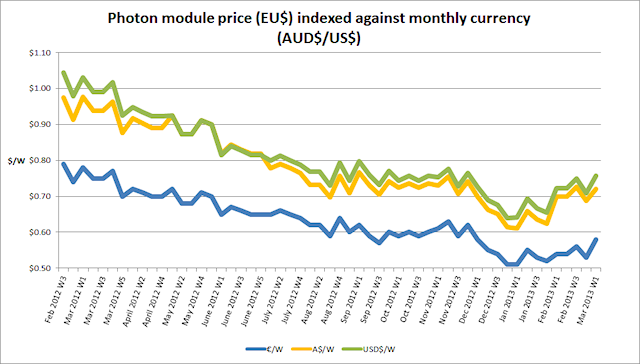2013 looks to be a year of consolidation and rising solar panel prices, both in Australia and internationally. Solar photovoltaic (PV) system installation prices have fallen dramatically since only a few years ago, and looking at the situation from outside one might have been forgiven for believing that this trend would continue indefinitely. However, the global oversupply of solar modules has eased slightly as demand has risen and manufacturing plants were shuttered across the globe, leaving only manufacturers who managed to weather the storm, and putting installers in a better position to–or with no choice but to–increase their prices.
Low solar panel prices have meant a rough ride for manufacturers…
The fact that the solar PV module manufacturing industry is in crisis has been in the news for almost 2 years now. Numerous high-profile European and North American solar panel manufacturers have entered insolvency proceedings or gone bankrupt since 2011, and the blame has been placed in great part part on the huge volumes of panels being manufactured in China and sold globally. This has lead to charges of solar panel ‘dumping’ against Chinese manufacturers, and has resulted in import tariffs being slapped on Chinese-made panels in the European and American markets. Chinese manufacturers are not exempt from the suffering, with rapid consolidation of the Chinese solar panel industry already underway. The biggest blow came recently, with global solar heavyweight Suntech defaulting on a $541 million bond payment.
…but good times for solar installers and customers
Because the solar panel manufacturing industry here is now limited to just 1 company, tariffs like those in the EU and the USA have not been applied in Australia, even with the vast majority of the market being comprised of Chinese products. Thanks to the relative laxness of the product approval process, Australia has become in effect a Mecca for lower-quality (and cheaper) product that would have had difficulty meeting the more stringent requirements of EU and US certification. Additionally, with so many of the smaller Chinese manufacturers facing a dubious future, Australia has become the destination for Chinese panels sold at ‘fire sale’ rates–often below the cost of manufacture. Although it is the case that Australian solar customers are becoming increasingly wary of such low-end systems, their presence on the market has helped to drive competition and resulted in an overall deflation of system installation prices–even for many of those which use more expensive, usually higher quality components. This dynamic has benefited many solar PV system installation companies, as well as the huge number of households and businesses that have gone solar during this period.
Are the good times over? No, but dirt-cheap systems likely to be harder to find
This downward trend is unsustainable, however, and 2013 looks to be the year of reckoning. Paula Mints, principle analyst of the solar program at Navigant, has been pointing this out for some time now: “If you take a look at the financial statements of any manufacturer, they are losing money at today’s price point. I’m constantly astounded when people say these prices are legitimate and we have to go even lower – did you look at the quarterly statement? These prices are not supportable,” she said in an interview with PV-Tech. MIT’s Technology Review has taken a slightly different angle on the phenomenon, going so far as to identify the collapse of solar manufacturers a positive thing for the solar industry, publishing an article in response the the Suntech debacle provocatively titled: ‘Why we need more solar companies to fail‘.
Here in Australia, Nigel Morris of Solar Business Services points to recent data from Photon Magazine showing that average solar system prices are indeed already on the rise after a low point in January 2013, although cheaper systems will still be available–the main factor driving up the average system price may be the dropping off of products from the lower end of the market. “Although we remain bullish on the year, clearly PV sales are no longer falling from the sky and all the while costs are rising and operational efficiencies diminishing,” said Morris.
Solar module prices indexed by currency–Australia in orange. Image via Solar Business Services.
© 2013 Solar Choice Pty Ltd
- Solar Power Wagga Wagga, NSW – Compare outputs, returns and installers - 13 March, 2025
- Monocrystalline vs Polycrystalline Solar Panels: Busting Myths - 11 November, 2024
- Solar Hot Water System: Everything You Need to Know - 27 February, 2024
